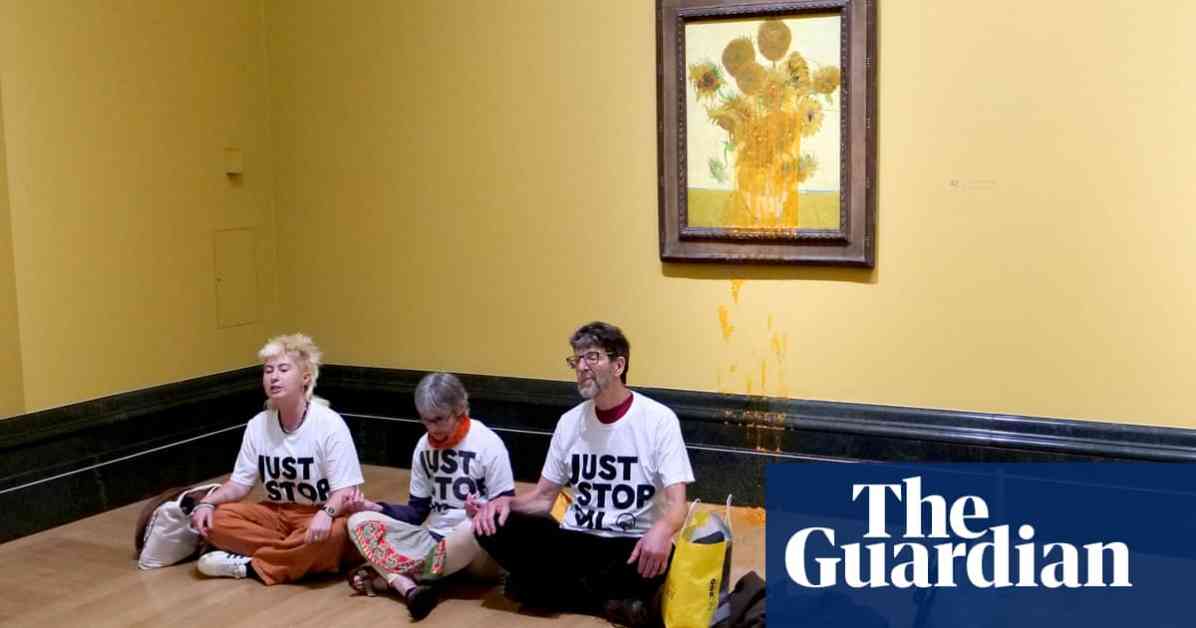Activists Protest by Splattering Soup on Van Gogh’s Sunflowers
Climate activists continue to make headlines with their bold and controversial protest actions. In a recent act of defiance, three supporters of Just Stop Oil took it upon themselves to throw tomato soup over two iconic Sunflowers paintings by the legendary artist Vincent van Gogh. This protest, which occurred at the National Gallery in London, comes just hours after two other activists were sentenced to prison for a similar action in 2022.
Defiance in the Name of Climate Justice
The activists, undeterred by the legal consequences faced by their predecessors, walked into the National Gallery on a Friday afternoon and targeted the Sunflowers paintings from 1888 and 1889. These paintings, known for their vibrant colors and masterful brushstrokes, were splattered with Heinz soup as a symbolic gesture of protest against the fossil fuel industry and its impact on the environment.
One of the participants, Phil Green, boldly declared to gallery visitors, “Future generations will regard these prisoners of conscience to be on the right side of history.” This sentiment was echoed by 71-year-old Ludi Simpson, who emphasized the need for accountability in the face of environmental destruction. “When will the fossil fuel executives and the politicians they’ve bought be held accountable for the criminal damage that they are imposing on every living thing?” Simpson questioned.
Consequences of Civil Disobedience
The protest action took place just an hour after Phoebe Plummer and Anna Holland were sentenced to prison for their role in a similar protest in 2022. Plummer, 23, received a two-year sentence, while Holland, 22, was sentenced to 20 months for causing damage to the frame of Sunflowers 1888. The judge presiding over the case, Christopher Hehir, condemned the actions of the defendants, highlighting the potential irreparable harm that could have been caused to the priceless artwork.
Despite facing imprisonment, Plummer and Holland remained defiant, embracing each other and blowing kisses to the public gallery before being led away. This act of solidarity and unwavering commitment to their cause underscores the dedication of these activists to fight for climate justice at any cost.
A Symbolic Act of Resistance
The protest in the National Gallery was not an isolated incident but part of a larger movement of civil disobedience aimed at raising awareness about the urgent need for environmental action. Plummer, in a poignant address to the judge, referenced historical figures such as Emmeline Pankhurst, Mahatma Gandhi, and Nelson Mandela as examples of individuals who had faced criminalization in their pursuit of justice.
Plummer’s words resonated with the audience as she spoke about the necessity of non-violent civil resistance in the face of the climate emergency. “I made those choices because I believe that non-violent civil resistance is the best, if not the only, tool that people have in order to bring about the rapid change required to protect life from the accelerating climate emergency,” Plummer stated.
Judge Hehir, in delivering the sentence, emphasized the gravity of the defendants’ actions and the potential harm that could have been inflicted on the artwork. He acknowledged the incalculable nature of the harm that could have been caused had the soup seeped behind the glass covering the painting. Despite the damage to the frame, gallery staff acted swiftly to ensure the painting was not seriously harmed.
In conclusion, the protest at the National Gallery serves as a poignant reminder of the power of civil disobedience in the fight for environmental justice. The activists’ bold actions may have caused controversy and legal repercussions, but they have also sparked important conversations about the urgent need for action to address the climate crisis. As the world grapples with the devastating effects of climate change, these activists stand as a beacon of hope and resilience in the face of adversity.












